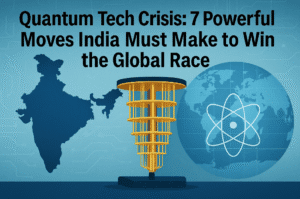Quantum Tech Crisis: 7 Powerful Moves India Must Make to Win the Global Race
India is positioning itself in the global quantum race, yet faces major hurdles in funding, hardware development, and global standard-setting. With only $30 million in private investments, India lags behind quantum leaders like the U.S. and U.K., despite ranking sixth in startups. The country’s overreliance on angel investors and foreign hardware highlights the urgent need for institutional funding and domestic manufacturing capabilities.
Strategic public-private partnerships, hardware R&D hubs, and participation in global standards bodies are vital for India’s technological sovereignty. While strong in quantum software and algorithm development, India must foster deeper collaboration between academia, industry, and government. The National Quantum Mission, if steered well, could anchor innovation and build hardware independence. Upskilling STEM talent and engaging the diaspora will be critical to sustaining momentum.
As quantum technology redefines global power structures, India’s proactive, unified approach will determine its role in this next frontier.

Quantum Tech Crisis: 7 Powerful Moves India Must Make to Win the Global Race
The global quantum technology landscape is rapidly evolving, and India is striving to carve its niche. A recent report by the Office of the Principal Scientific Adviser (PSA), the International Technology Engagement Strategy for Quantum (ITES-Q), paints a vivid picture of India’s current standing—a nation brimming with potential but facing critical gaps in funding, infrastructure, and global influence. Here’s a deep dive into what the findings mean for India’s quantum future and how the country can pivot to compete on the world stage.
India’s Quantum Ecosystem: A Snapshot
India has secured $30 million in private quantum tech investments, a figure dwarfed by global leaders like the U.S. ($6.9 billion) and the U.K. ($1.44 billion). While the country ranks 6th globally in quantum startups (53 ventures), it trails significantly behind the U.S. (309), Germany (110), and China (63). The report underscores a stark reality: India’s quantum ambitions hinge on bridging funding disparities, nurturing hardware innovation, and fostering cross-sector collaboration.
The Funding Conundrum: Why Private Investment Matters
Quantum technologies—spanning computing, communication, and sensing—require long development cycles and substantial capital. Unlike the U.S. and Europe, where deep-tech venture capital and government-backed funds dominate, India’s quantum startups rely heavily on angel investors. This limits scalability, as institutional investors (VCs, corporates) remain cautious.
Dr. Parvinder Maini, Scientific Secretary to the PSA, highlights the need for patient capital: “Quantum breakthroughs take years. India needs institutional investors willing to support startups through this gestation period.” Countries like Germany have leveraged public-private partnerships (PPPs) and corporate consortia to de-risk investments—a model India could emulate.
The Hardware Gap: A Vulnerability
A critical takeaway from the ITES-Q report is India’s dependence on imported quantum hardware. While the country excels in software and algorithm development, it lags in manufacturing core components like qubits, cryogenic systems, and photonic devices.
Dr. Ajay Kumar Sood, PSA, emphasizes, “Investing in domestic hardware R&D is non-negotiable for strategic autonomy.” Initiatives like the National Quantum Mission could prioritize grants for homegrown hardware innovation, reducing reliance on foreign suppliers.
Global Standards: The Unseen Battlefield
Quantum technology isn’t just about innovation—it’s about shaping the rules. The report warns that India’s absence from global standard-setting bodies could marginalize its influence. “Without a seat at the table, we risk adopting external standards that don’t align with India’s interests,” notes Dr. Sood. Participation in forums like the International Telecommunication Union (ITU) or IEEE Quantum Initiative is crucial to ensure India’s market access and security needs are reflected.
Startups and Academia: Building Synergies
India’s 53 quantum startups—focusing on encryption, quantum software, and AI integration—show promise. However, fragmented collaboration between academia, industry, and government stifles progress.
Dr. Naveen Kumar Malik of HCLTech stresses, “Corporate R&D partnerships can accelerate commercialization.” For instance, joint ventures between startups and IT giants could fast-track quantum-safe cybersecurity solutions for sectors like banking and defense.
A Roadmap for India’s Quantum Leap
- Boost Institutional Funding: Create government-backed VC funds tailored for deep-tech, incentivizing private investors through tax breaks or matched funding.
- Build Hardware Competence: Establish dedicated R&D hubs for quantum materials and devices, partnering with manufacturing giants like Tata or Reliance.
- Forge Global Alliances: Launch bilateral quantum partnerships with QUAD nations or the EU to share knowledge and resources.
- Upskill Talent: Expand STEM programs with quantum specializations and attract diaspora experts through competitive grants.
- Drive Demand: Government can act as an anchor customer for quantum solutions, spurring market confidence.
The Road Ahead
The ITES-Q report isn’t just a wake-up call—it’s a blueprint. Quantum technology promises transformative impacts across healthcare, logistics, and national security. For India, the path forward demands strategic investments, cohesive policies, and a mindset shift from jugaad innovation to sustained, collaborative deep-tech growth. As global players race toward quantum supremacy, India’s ability to mobilize its private sector, academia, and political will could determine whether it becomes a leader or remains a spectator in this trillion-dollar revolution.
You must be logged in to post a comment.